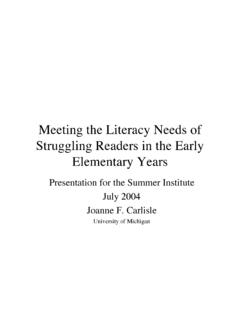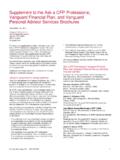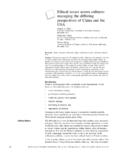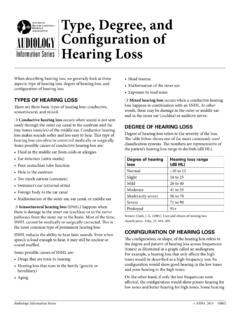Transcription of Teacher Rating of Oral Language and Literacy
1 Teacher Rating of Oral Language and Literacy (TROLL): A Research-Based ToolCIERA Report #3-016 David K. Dickinson, Educational Development CenterAllyssa McCabe, university of Massachusetts LowellKim Sprague, Educational Development CenterCIERA Inquiry 3: Policy and ProfessionWhat is the Teacher Rating of Oral Language and Literacy (TROLL)? Can it provide an accurate measure of students Literacy acquisition skills?In this article, we describe the Teacher Rating of Oral Language and Literacy (TROLL), an instrument that measures skills identified as critical in the NewStandards for Speaking and Listening (Tucker & Codding, 1998).
2 In 5 10minutes and without prior training, teachers can assess an individual child scurrent standing with respect to skills that research has identified as criticalfor Literacy acquisition. Skills assessed include Language , reading, and writingabilities. TROLL has been used with over 900 low-income children. Theinstrument is reliable and has strong internal consistency. Its validity hasbeen established in numerous ways; TROLL correlates significantly withscores on the Peabody Picture Vocabulary Test and the Early PhonemicAwareness Profile given to the same children by trained researchers.
3 FallTROLL judgements of the Literacy skills of these same children correlatewith fall but not spring assessments of Literacy skills obtained with the EarlyLiteracy Profile. TROLL also displays instructional for the Improvement of Early Reading AchievementUniversity of Michigan Ann ArborSeptember 20, 2001 university of Michigan School of Education610 E university Ave., Rm 1600 SEBAnn Arbor, MI 2001 Center for the Improvement of Early Reading research was supported under the Educational Research and Develop-ment Centers Program, PR/Award Number R305R70004, as administered bythe Office of Educational Research and Improvement, Department ofEducation.
4 However, the comments do not necessarily represent the posi-tions or policies of the National Institute of Student Achievement, Curricu-lum, and Assessment or the National Institute on Early ChildhoodDevelopment, or the Department of Education, and you should notassume endorsement by the Federal Rating of Oral Language and Literacy (TROLL): A Research-Based ToolDavid K. Dickinson, Educational Development CenterAllyssa McCabe, university of Massachusetts LowellKim Sprague, Educational Development CenterTo be able to read and write, children first must develop sufficient oral lan-guage skills (Dickinson & McCabe, 1991; Dickinson & Tabors, 2001; Snow1983; Snow, Burns, & Griffin, 1998).
5 Oral Language skills blossom during thepreschool years, which means that they are also very vulnerable and in needof stimulation during this time, as a number of major organizations involvedin the education of young children have speaking and listening are so critical for Literacy development inearly childhood, the New Standards project, a program of the National Cen-ter on Education and the Economy (Tucker & Codding, 1998), has devel-oped research-based standards for speaking and listening for preschoolthrough third grade.
6 These standards complement those already developedfor reading and writing. Speaking and listening standards include many spe-cific recommendations for teachers regarding beneficial habits of conversa-tion, useful kinds of talk such as narratives and explanations, and languageconventions relevant to early childhood. Many programs will be concernedto see that their students meet such national is a quiet, attractive Hispanic girl, with long wavy black hair alwaystied back neatly into a ponytail and large brown eyes that seem to studyeverything around her.
7 Her Teacher has observed that she is shy with otherchildren, reluctant to participate in group choruses, and often the last to joina line or in clean-up activities. Still, the Teacher has never had to reprimandAnna. Only when the Teacher sits down to fill out reports on the languagedevelopment of each of her students does she realize Anna has a problem. A Call for Developmentally Appropriate AssessmentIn 1998, the International Reading Association (IRA) and the National Associ-ation for the Education of Young Children (NAEYC) joined together to for-mulate a position statement regarding early Literacy development.
8 TheCIERA Report 3-0162statement acknowledges the difficulty that teachers face, for example, inkindergarten classrooms where a five-year range in children s Literacy -relatedskills is not uncommon (Riley, 1996). Estimating where each child is interms of the acquisition of speaking, listening, reading, and writing skills iscritical in order to provide developmentally appropriate instruction to allchildren in this wide range. The position statement ( , emphasis ours) isquite clear that throughout these critical years accurate assessment of children s knowledge, skills, and dispositions in reading and writing will help teachers better match instruction with how and what children are learning.
9 However, early reading and writing cannot simply be mea-sured as a set of narrowly defined skills on standardized tests. These measures often are not reliable or valid indicators of what children can do in typical practice, nor are they sensitive to Language varia-tion, culture, or the experiences of young children. As if these difficulties were not enough, teachers typically have not beentrained to evaluate children s Language development as it relates to the acqui-sition of Literacy .
10 In response to this need, this report presents an accessiblemeans of evaluating each child in your classroom for Literacy -related lan-guage development. Periodic evaluation of children using this tool willenable teachers and programs to assess and demonstrate their Development of TROLL The Teacher Rating of Oral Language and Literacy (TROLL) is a Rating tooldeveloped by David Dickinson to provide teachers with a way to track thelanguage and Literacy development of children in their classrooms.












